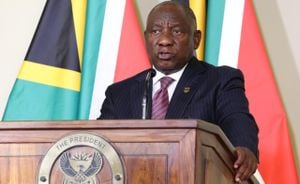The conflict between Ukraine and Russia has escalated significantly as Ukraine embarks on its most ambitious cross-border operation since the war began. Recent military actions have seen Ukrainian troops advance deep inside Russian territory, raising concerns about the potential for broader escalation.
Ukrainian forces have reportedly moved between one and three kilometers within Russia's Kursk region. They have managed to destroy key infrastructure, including a road bridge over the Seym River.
Officials from Kyiv have claimed this attack challenges Russian defenses and demonstrates weaknesses within their military capabilities. The strikes prompted mass evacuations of civilians from nearby areas, as local leaders anticipate more aggressive military actions.
Adding complexity to the situation, Nikolai Patrushev, a close aide to President Putin, accused Western powers of orchestrally assisting Ukraine's assault. He suggested this offensive could lead to critical consequences for Ukraine's sovereignty.
On the ground, Russian military operations are advancing rapidly toward the eastern Ukrainian city of Pokrovsk. The urgency of evacuation orders reflects Moscow's sustained interest in capturing the city, which is seen as strategically important for future operations.
Ukrainian President Volodymyr Zelenskyy claims his forces are making territorial gains. He emphasized their control of 82 settlements over approximately 1,150 square kilometers since launching their recent incursion on August 6.
Western nations, including the United States, have been careful to maintain their distance from direct military involvement. Despite providing advanced weaponry, they assert Ukraine has acted independently without prior warning of the cross-border strikes.
The situation on the ground remains highly fluid, with Ukrainian officials highlighting the rapid pace at which Russian troops are advancing. Civilians are being encouraged to evacuate as military confrontations intensify.
While Ukraine's allies withhold firm judgments on the effectiveness and goals of these new military actions, the operation has sparked discussions across international forums. Analysts are especially focused on the potential fallout of such daring military maneuvers.
Despite Kyiv’s aggressive tactics, Russian leadership insists these incursions will not alter the war's course. Moscow continues to frame their efforts as necessary to protect national interests against encroachment from NATO and the West.
The humanitarian situation remains dire, with civilians caught in the crossfire as fighting escalates. Aid groups are calling for urgent humanitarian access to assist those displaced by the recent turmoil.
Experts believe the long-term impact of these incursions may reshape perceptions of both militaries involved. It highlights not just the tactical advancements but also the underlying strategic calculations at play.
Throughout this conflict, narratives have diverged between the two sides, complicate public perceptions. Whether this new offensive will be seen as successful or reckless is still up for debate.
With significant military resources at play, the war's dynamics are continuing to shift. Strategic gains by Ukraine might boost their international support, whereas failures could stoke criticism from within their ranks.
The dramatic cross-border actions come against the backdrop of months of intense fighting. Moscow’s narrative downplays the significance of these events, branding them as temporary setbacks rather than decisive losses.
Rising tensions have led to increased military readiness on both sides, as leaders gear up for prolonged engagements. The international community is once again reminded of the potential for larger conflicts, ignited by localized skirmishes.
Both armies are bracing for possible retaliations, which could complicate the already volatile operational environment. The focus now shifts to how Germany and other Western nations respond to these developments and the support they are willing to provide to Ukraine.
Military experts are watching the flow of combat closely, noting the importance of key geographical regions. The outcomes of these engagements could be pivotal for future operations along the extensive 1,000-km front.
Ukraine’s decision to strike at the heart of Russian territory represents not just tactical maneuvers but also strong messaging against Moscow’s asserted dominance. The move could invigorate Ukrainian resolve but also place additional pressure on leaders to deliver results.
International reactions vary, with some countries wary of overcommitting to support Ukraine amid potential retaliatory measures from Russia. The geopolitical ramifications of these hostilities may redefine alliances and encourage fresh dialogues about military support.
While local civilian populations bear the brunt of these military exchanges, global observers look on with mixed feelings. The stakes are extremely high, and as the situation develops, the world watches closely, searching for footing between national sovereignty and aggressive territorial defense.
The offensive against Kursk serves as this conflict’s latest chapter—a reminder of the persistence of war and the complex motivations driving leaders. The consequences of these military decisions will unfurl over time as each side recalibrates their strategies.
With evictions and escalations on both sides of the border, tensions are expected to persist as long as military operations continue. Continued scrutiny from global powers remains likely as Kyiv seeks both assistance and validation for its actions, especially as the world watches for any sign of changing dynamics.
The war’s evolution reminds us of the unpredictable nature of armed conflict. Each tactical success and risk taken by Ukrainian forces adds to the unpredictable tableau of this continuing dramatic conflict.



